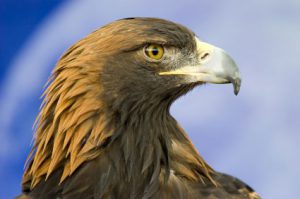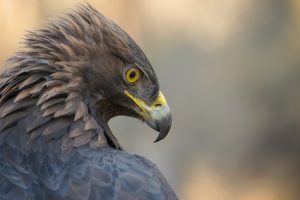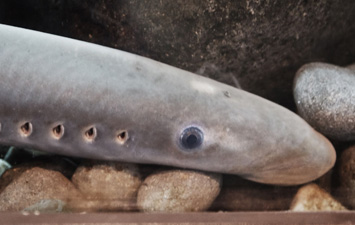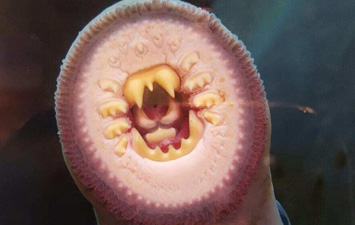Since its inception, a cornerstone of the High Desert Museum has been maintaining the Donald M. Kerr Birds of Prey Center and its collection of rehabilitated birds. It is a critical part of educating people about the support necessary for several species’ survival. 
This is the story of the golden eagle on exhibit. His name is Phillip.
The High Desert regions of Wyoming, Utah, Nevada, Idaho, Oregon and Washington have become an important refuge for the golden eagle, a species whose breeding range once encompassed large tracts of the northern hemisphere. The vast high desert in the West still offer isolated nesting sites and the surrounding sagebrush seas offer abundant food in the form of jackrabbits, ground squirrels rodents and other birds.
However, raptor biologists began realizing that populations in the High Desert were declining, threatened by a number of human-based causes including electrocutions; car strikes; habitat degradation and loss, including higher exposure to people, exposure of isolated nesting sites, and threats to food resources; exposure to lead; and persecution in the form of shooting, trapping, and deliberate poisoning. In addition, people often ask about wind turbines affect the golden eagle population. While it is an active area of study, power lines and cars kill far more raptors than wind turbines.
Biologists believed these issues presented an alarming future for this apex predator. Based on these concerns, in 2013 the U.S. Fish & Wildlife Service established the Western Golden Eagle Conservation Team. Its mission is to evaluate the various threats to golden eagles and recommend conservation strategies to curb mortality rates.
This is where the Donald M. Kerr Birds of Prey Center comes in. It has in residence many birds of prey that were injured in the wild. Those injuries were so severe they resulted in permanent disability, at which a point a wildlife veterinarian deemed them non-releasable. In these cases, the birds were evaluated and based on the findings, euthanized or transferred to an education facility such as the High Desert Museum.
At the High Desert Museum, birds of prey, including its three golden eagles, are wildlife ambassadors, working with Museum staff to educate the public. Staff talk with visitors about raptor conservation and demonstrate the power and magnificence of these birds through free-flight programs and interpretive talks. Nothing is more impressive than a golden eagle standing on a perch 10 feet away. Visitors experience first hand the keen gaze of the eagle that can spot prey far away and the enormous spread of its wings that, when healthy, would have carried them miles, soaring above the High Desert.
Visitors also learn about their habitats and habits, and how we can all participate in minimizing human-cased threats to ensure their survival. For example, lead poisoning in birds of prey.
In addition to live rodents, rabbits, ground squirrels and other birds, golden eagles feed on carrion in the wild. And this carrion, often remains left by hunters, carries lead from bullets that gets ingested by golden eagles. Once lead is incorporated into the bloodstream at a large enough concentration, a bird can become very sick, exhibiting a range of neurological symptoms, such as tremors, convulsions, lack of coordination, and paralysis of the digestive system.
If the bird gets a large dose it can deteriorate and die directly from the lead poisoning. However, even at lower concentrations, lead in a raptor’s system impacts motor control and reaction times, likely contributing to other kinds of injury or mortality. This would account for why so many birds taken to rehabilitation centers for various mechanical injuries also turn out to have been exposed to lead.
According to the American Bird Conservancy, millions of birds are poisoned by lead every year. Unfortunately, only a portion of these find poisoned birds find help at raptor rehabilitation centers like Blue Mountain Wildlife in Pendleton, Oregon, and eventual homes at facilities like the High Desert Museum in Bend, Oregon. Switching to alternative source of ammunition, such as copper, would prevent many majestic birds of prey from being poisoned.
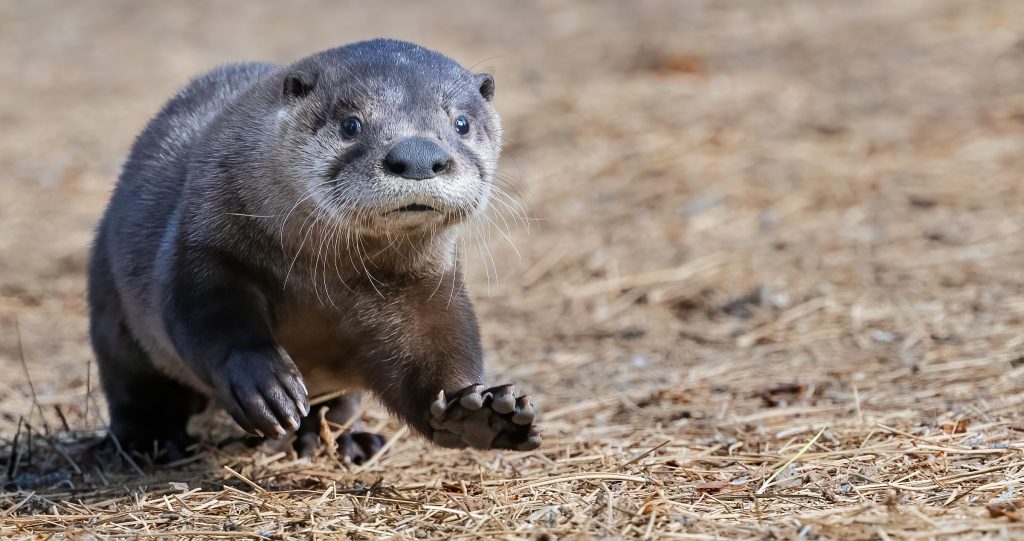

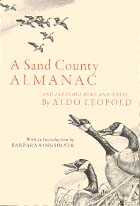 A Sand County Almanac by Aldo Leopold
A Sand County Almanac by Aldo Leopold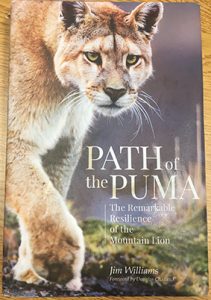 Path of the Puma: The Remarkable Resilience of the Mountain Lion by Jim Williams
Path of the Puma: The Remarkable Resilience of the Mountain Lion by Jim Williams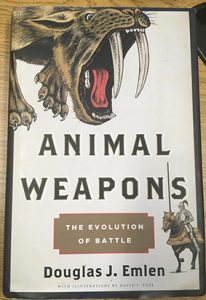 Animal Weapons: The Evolution of Battle by Douglas J. Emlen
Animal Weapons: The Evolution of Battle by Douglas J. Emlen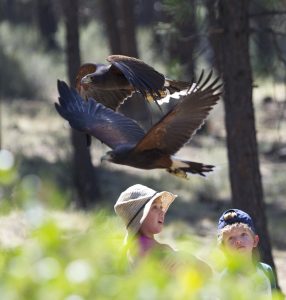 Of all the animals cared for at the Museum, raptors are perhaps what we are best known for. Twenty-eight nonreleasable birds call the Museum home, half of which participate in Raptors of the Desert Sky.
Of all the animals cared for at the Museum, raptors are perhaps what we are best known for. Twenty-eight nonreleasable birds call the Museum home, half of which participate in Raptors of the Desert Sky.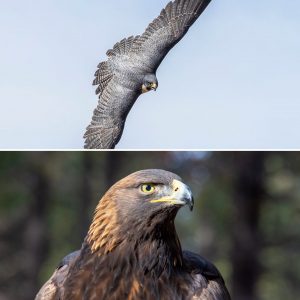 Each day each bird can choose to participate in the program. It turns out raptors aren’t that different from people. They have stage fright. They get tired. They have bad days. They don’t have to fly if they don’t want to. Another can take their place. Some, like Pefa the peregrine, are fearless, confident and highly motivated. She rarely misses a show. Others, like Walter the golden eagle, can be shy and easily overwhelmed. They might only make occasional appearances. That’s okay, as it’s all about providing the highest possible welfare to the animals we care for while sharing them with our community, and it makes for a dynamic program.
Each day each bird can choose to participate in the program. It turns out raptors aren’t that different from people. They have stage fright. They get tired. They have bad days. They don’t have to fly if they don’t want to. Another can take their place. Some, like Pefa the peregrine, are fearless, confident and highly motivated. She rarely misses a show. Others, like Walter the golden eagle, can be shy and easily overwhelmed. They might only make occasional appearances. That’s okay, as it’s all about providing the highest possible welfare to the animals we care for while sharing them with our community, and it makes for a dynamic program.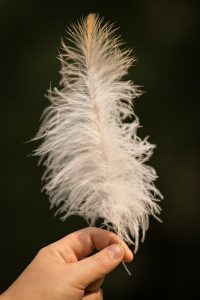 With that volume of education and outreach, raptor handlers quickly learn to anticipate the questions of a curious audience. Wildlife staff works tirelessly with our birds so they are comfortable with people getting close. Once close, people naturally want to touch. Being able to feel and hold something is a crucial component of an educational program. Touching has the potential to create powerful learning experiences. There’s a lot you can learn from holding a feather or talon, turning it in your hand, and feeling it in your fingers that would be imperceptible simply looking at a bird from across the room.
With that volume of education and outreach, raptor handlers quickly learn to anticipate the questions of a curious audience. Wildlife staff works tirelessly with our birds so they are comfortable with people getting close. Once close, people naturally want to touch. Being able to feel and hold something is a crucial component of an educational program. Touching has the potential to create powerful learning experiences. There’s a lot you can learn from holding a feather or talon, turning it in your hand, and feeling it in your fingers that would be imperceptible simply looking at a bird from across the room. 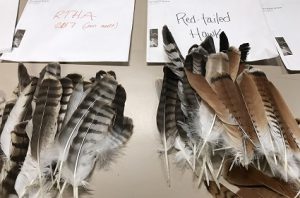 Every year in January the Museum’s wildlife staff prepares a report for U.S. Fish and Wildlife Service detailing the use of every live bird and bird part in the collection, including feathers that are part of historical and cultural objects on display. In our By Hand Through Memory permanent exhibition alone there are more than 200 bald and golden eagle feathers on exhibit, each one meticulously identified and inventoried by dedicated collections volunteers. Each item is required by law to be made available to the public a minimum of 12 times per year or for 400 hours, a benchmark the Museum far exceeds by providing exhibitions and programs to the Central Oregon community and visitors 362 days a year.
Every year in January the Museum’s wildlife staff prepares a report for U.S. Fish and Wildlife Service detailing the use of every live bird and bird part in the collection, including feathers that are part of historical and cultural objects on display. In our By Hand Through Memory permanent exhibition alone there are more than 200 bald and golden eagle feathers on exhibit, each one meticulously identified and inventoried by dedicated collections volunteers. Each item is required by law to be made available to the public a minimum of 12 times per year or for 400 hours, a benchmark the Museum far exceeds by providing exhibitions and programs to the Central Oregon community and visitors 362 days a year. 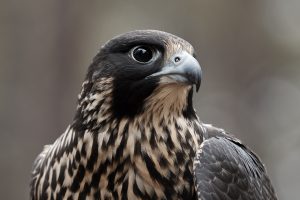 Late last summer a new resident arrived at the Museum, one with a particularly dramatic and colorful past that paints a vivid picture of the recovery of her species from near extinction, and of the challenges they face in new habitats today. She is a peregrine falcon named “Hope,” one of a clutch of four hatched by wild parents high upon a building in Tacoma, Washington.
Late last summer a new resident arrived at the Museum, one with a particularly dramatic and colorful past that paints a vivid picture of the recovery of her species from near extinction, and of the challenges they face in new habitats today. She is a peregrine falcon named “Hope,” one of a clutch of four hatched by wild parents high upon a building in Tacoma, Washington.